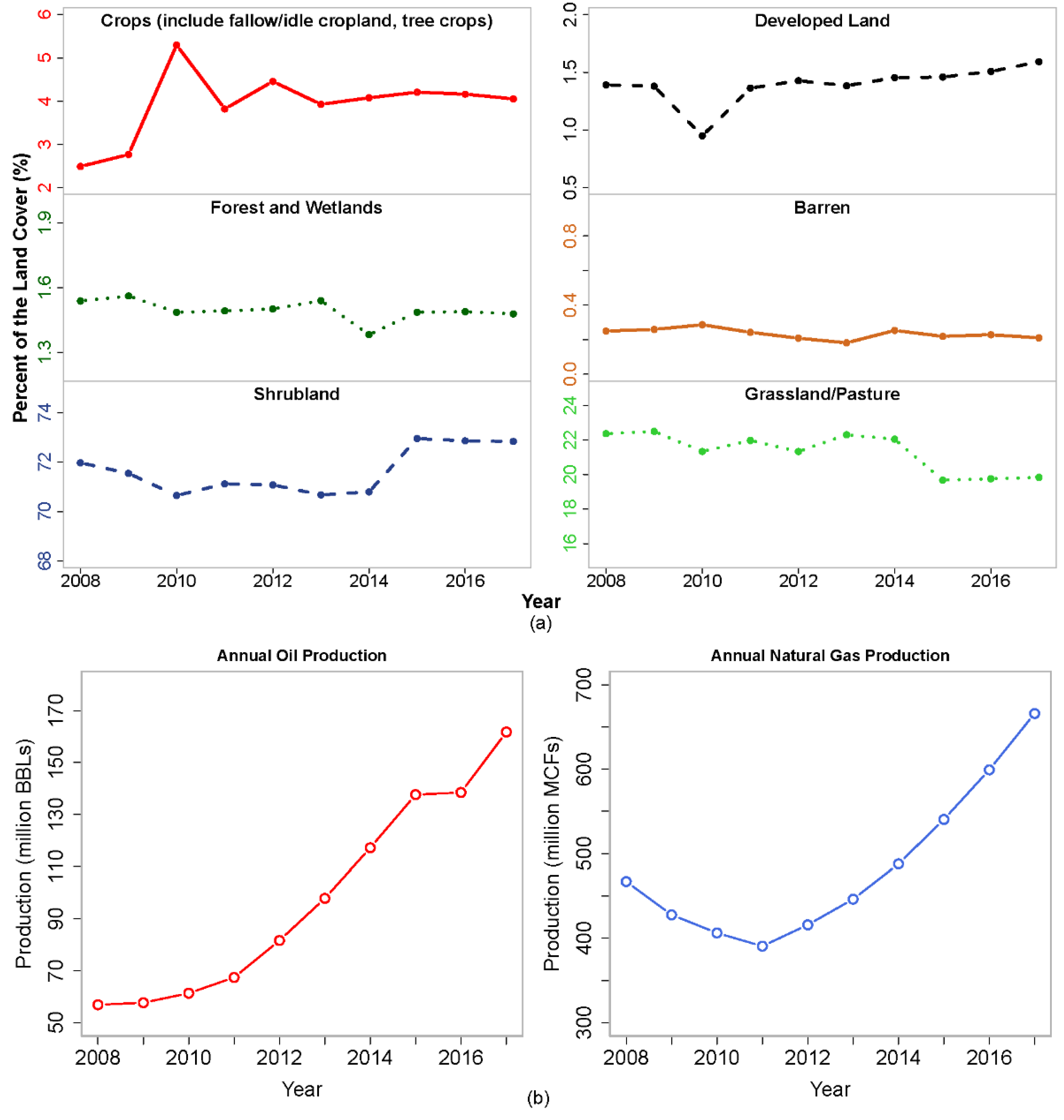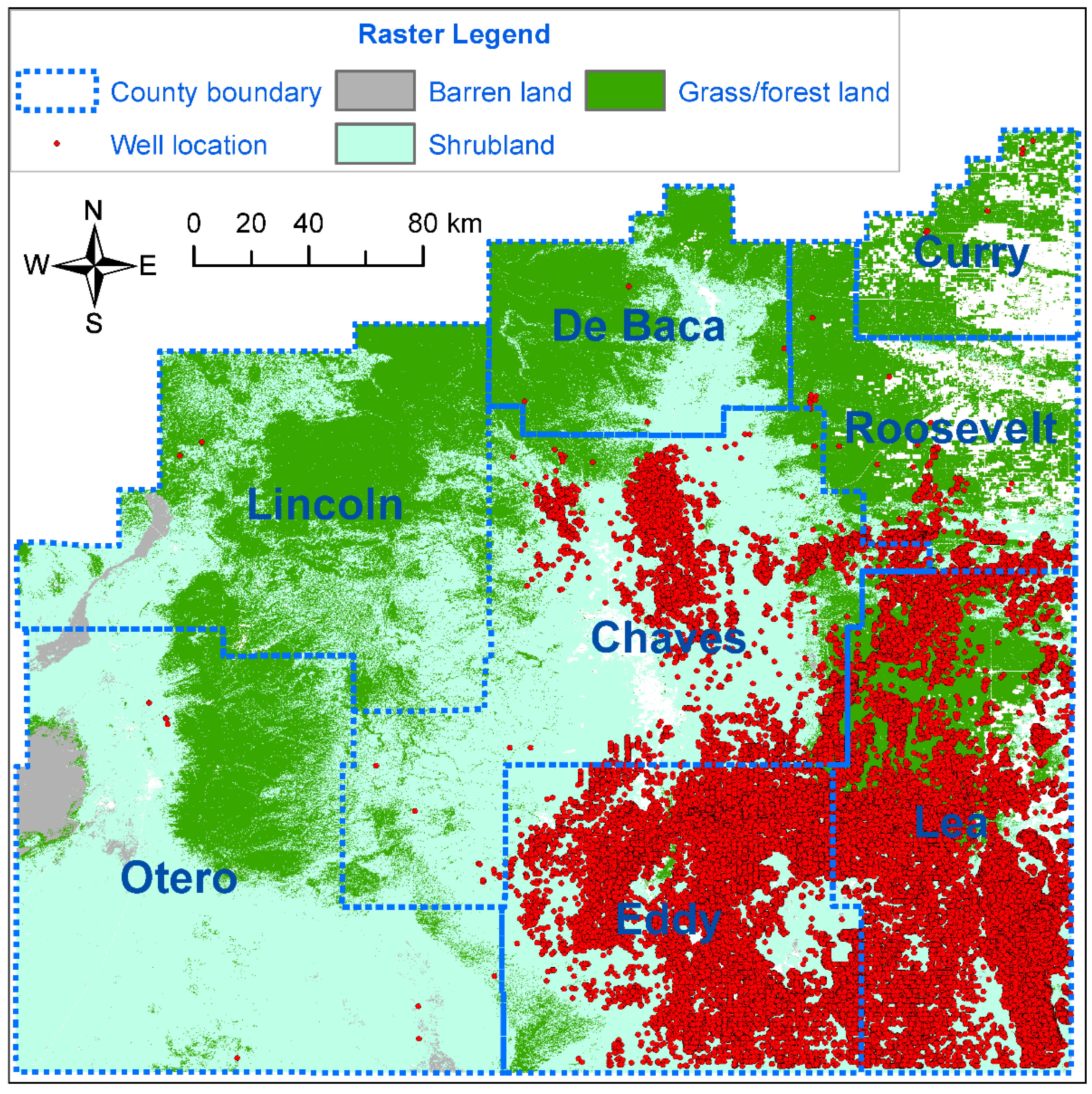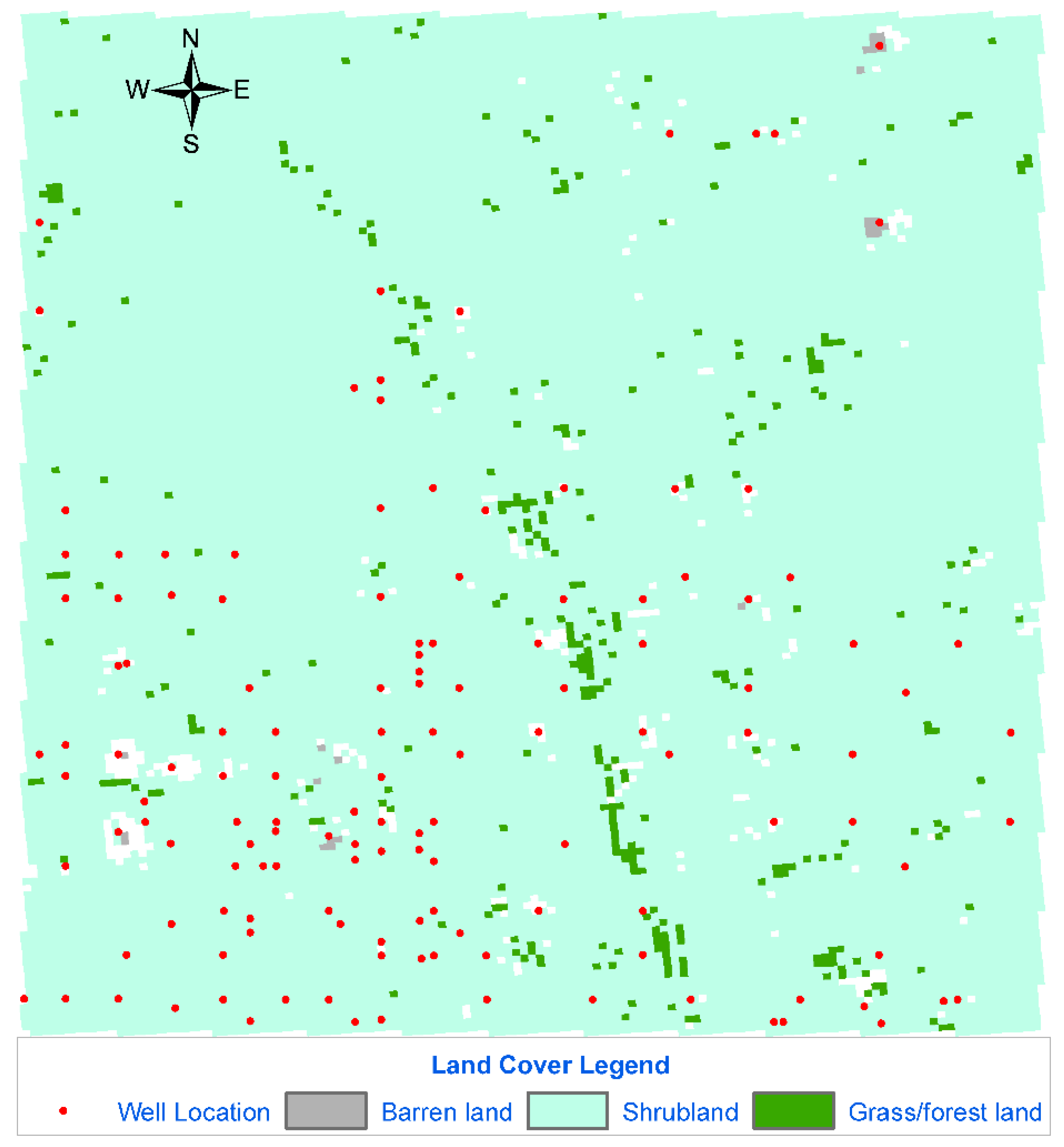The Impact of Shale Oil and Gas Development on Rangelands in the Permian Basin Region: An Assessment Using High-Resolution Remote Sensing Data
Abstract
1. Introduction
2. Materials and Methods
2.1. Study Area
2.2. Empirical Method
2.3. Land Cover Data
2.4. Oil and Natural Gas Production Data
2.5. Climatic Data
3. Results and Discussion
4. Policy and Management Implications
5. Concluding Remarks
Supplementary Materials
Author Contributions
Funding
Institutional Review Board Statement
Informed Consent Statement
Data Availability Statement
Acknowledgments
Conflicts of Interest
References
- Goldewijk, K.K.; Ramankutty, N. Land cover change over the last three centuries due to human activities: The availability of new global data sets. GeoJournal 2004, 61, 335–344. [Google Scholar] [CrossRef]
- Sukopp, H. Human-caused impact on preserved vegetation. Landsc. Urban Plan. 2004, 68, 347–355. [Google Scholar] [CrossRef]
- Wang, H. Change of vegetation cover in the US–Mexico border region: Illegal activities or climatic variability? Environ. Res. Lett. 2019, 14, 054012. [Google Scholar] [CrossRef]
- Allred, B.W.; Smith, W.K.; Twidwell, D.; Haggerty, J.H.; Running, S.W.; Naugle, D.E.; Fuhlendorf, S.D. Ecosystem services lost to oil and gas in North America. Science 2015, 348, 401–402. [Google Scholar] [CrossRef]
- Northrup, J.M.; Wittemyer, G. Characterising the impacts of emerging energy development on wildlife, with an eye towards mitigation. Ecol. Lett. 2013, 16, 112–125. [Google Scholar] [CrossRef] [PubMed]
- Jacquet, J.B. Review of risks to communities from shale energy development. Environ. Sci. Technol. 2014, 48, 8321–8333. [Google Scholar] [CrossRef] [PubMed]
- Kreuter, U.P.; Iwaasa, A.D.; Theodori, G.L.; Ansley, R.J.; Jackson, R.B.; Fraser, L.H.; Naeth, M.A.; McGillivray, S.; Moya, E.G. State of knowledge about energy development impacts on North American rangelands: An integrative approach. J. Environ. Manag. 2016, 180, 1–9. [Google Scholar] [CrossRef]
- Partridge, T.; Thomas, M.; Harthorn, B.H.; Pidgeon, N.; Hasell, A.; Stevenson, L.; Enders, C. Seeing futures now: Emergent US and UK views on shale development, climate change and energy systems. Glob. Environ. Chang. 2017, 42, 1–12. [Google Scholar] [CrossRef]
- McBroom, M.; Thomas, T.; Zhang, Y. Soil erosion and surface water quality impacts of natural gas development in east Texas, USA. Water 2012, 4, 944–958. [Google Scholar] [CrossRef]
- Fontenot, B.E.; Hunt, L.R.; Hildenbrand, Z.L.; Carlton Jr, D.D.; Oka, H.; Walton, J.L.; Hopkins, D.; Osorio, A.; Bjorndal, B.; Hu, Q.H.; et al. An evaluation of water quality in private drinking water wells near natural gas extraction sites in the Barnett Shale formation. Environ. Sci. Technol. 2013, 47, 10032–10040. [Google Scholar] [CrossRef]
- Olmstead, S.M.; Muehlenbachs, L.A.; Shih, J.S.; Chu, Z.; Krupnick, A.J. Shale gas development impacts on surface water quality in Pennsylvania. Proc. Natl. Acad. Sci. USA 2013, 110, 4962–4967. [Google Scholar] [CrossRef]
- Vidic, R.D.; Brantley, S.L.; Vandenbossche, J.M.; Yoxtheimer, D.; Abad, J.D. Impact of shale gas development on regional water quality. Science 2013, 340, 1235009. [Google Scholar] [CrossRef]
- MacDonald, G.M. Water, climate change, and sustainability in the southwest. Proc. Natl. Acad. Sci. USA 2010, 107, 21256–21262. [Google Scholar] [CrossRef]
- Pascale, S.; Boos, W.R.; Bordoni, S.; Delworth, T.L.; Kapnick, S.B.; Murakami, H.; Vecchi, G.A.; Zhang, W. Weakening of the North American monsoon with global warming. Nat. Clim. Chang. 2017, 7, 806–812. [Google Scholar] [CrossRef]
- Lee, J. The regional economic impact of oil and gas extraction in Texas. Energy Policy 2015, 87, 60–71. [Google Scholar] [CrossRef]
- Wang, H. The economic impact of oil and gas development in the Permian Basin: Local and spillover effects. Resour. Policy 2020, 66, 101599. [Google Scholar] [CrossRef]
- James, A.; Smith, B. There will be blood: Crime rates in shale-rich US counties. J. Environ. Econ. Manag. 2017, 84, 125–152. [Google Scholar] [CrossRef]
- Scanlon, B.R.; Reedy, R.C.; Male, F.; Walsh, M. Water issues related to transitioning from conventional to unconventional oil production in the Permian Basin. Environ. Sci. Technol. 2017, 51, 10903–10912. [Google Scholar] [CrossRef]
- Grover, H.D.; Musick, H.B. Shrubland encroachment in southern New Mexico, USA: An analysis of desertification processes in the American Southwest. Clim. Chang. 1990, 17, 305–330. [Google Scholar] [CrossRef]
- Beschta, R.L.; Donahue, D.L.; DellaSala, D.A.; Rhodes, J.J.; Karr, J.R.; O’Brien, M.H.; Fleischner, T.L.; Williams, C.D. Adapting to climate change on western public lands: Addressing the ecological effects of domestic, wild, and feral ungulates. Environ. Manag. 2013, 51, 474–491. [Google Scholar] [CrossRef] [PubMed]
- Johnson, D.M. A 2010 map estimate of annually tilled cropland within the conterminous United States. Agric. Syst. 2013, 114, 95–105. [Google Scholar] [CrossRef]
- Feyrer, J.; Mansur, E.T.; Sacerdote, B. Geographic dispersion of economic shocks: Evidence from the fracking revolution. Am. Econ. Rev. 2017, 107, 1313–1334. [Google Scholar] [CrossRef]
- van Auken, O.W. Causes and consequences of woody plant encroachment into western North American grasslands. J. Environ. Manag. 2009, 90, 2931–2942. [Google Scholar] [CrossRef] [PubMed]
- Moran, M.D.; Cox, A.B.; Wells, R.L.; Benichou, C.C.; McClung, M.R. Habitat loss and modification due to gas development in the Fayetteville Shale. Environ. Manag. 2015, 55, 1276–1284. [Google Scholar] [CrossRef]
- Johnstone, J.F.; Kokelj, S.V. Environmental conditions and vegetation recovery at abandoned drilling mud sumps in the Mackenzie Delta region, Northwest Territories, Canada. Arctic 2008, 61, 199–211. [Google Scholar] [CrossRef]
- Nash, M.; Wickham, J.; Christensen, J.; Wade, T. Changes in landscape greenness and climatic factors over 25 years (1989–2013) in the USA. Remote Sens. 2017, 9, 295. [Google Scholar] [CrossRef] [PubMed]
- Slonecker, E.T.; Milheim, L.E.; Roig-Silva, C.M.; Malizia, A.R.; Marr, D.A.; Fisher, G.B. Landscape Consequences of Natural Gas Extraction in Bradford and Washington Counties, Pennsylvania; US Geological Survey Open-File Report 2012–1154; U.S. Geological Survey: Reston, VA, USA, 2012. [Google Scholar]
- Drohan, P.J.; Brittingham, M.; Bishop, J.; Yoder, K. Early trends in land cover change and forest fragmentation due to shale-gas development in Pennsylvania: A potential outcome for the Northcentral Appalachians. Environ. Manag. 2012, 49, 1061–1075. [Google Scholar] [CrossRef]
- Thomas, E.H.; Brittingham, M.C.; Stoleson, S.H. Conventional oil and gas development alters forest songbird communities. J. Wildl. Manag. 2014, 78, 293–306. [Google Scholar] [CrossRef]
- Langlois, L.A.; Drohan, P.J.; Brittingham, M.C. Linear infrastructure drives habitat conversion and forest fragmentation associated with Marcellus shale gas development in a forested landscape. J. Environ. Manag. 2017, 197, 167–176. [Google Scholar] [CrossRef] [PubMed]
- Pattison, C.A.; Quinn, M.S.; Dale, P.; Catterall, C.P. The landscape impact of linear seismic clearings for oil and gas development in boreal forest. Northwest Sci. 2016, 90, 340–355. [Google Scholar] [CrossRef]
- Preston, T.M.; Kim, K. Land cover changes associated with recent energy development in the Williston Basin; Northern Great Plains, USA. Sci. Total Environ. 2016, 566, 1511–1518. [Google Scholar] [CrossRef]
- Jones, I.L.; Bull, J.W.; Milner-Gulland, E.J.; Esipov, A.V.; Suttle, K.B. Quantifying habitat impacts of natural gas infrastructure to facilitate biodiversity offsetting. Ecol. Evol. 2014, 4, 79–90. [Google Scholar] [CrossRef] [PubMed]
- Lam, D.K.; Remmel, T.K.; Drezner, T.D. Tracking desertification in California using remote sensing: A sand dune encroachment approach. Remote Sens. 2011, 3, 1–13. [Google Scholar] [CrossRef]
- Papke, L.E.; Wooldridge, J.M. Econometric methods for fractional response variables with an application to 401 (k) plan participation rates. J. Appl. Econom. 1996, 11, 619–632. [Google Scholar] [CrossRef]
- Braun, C.E.; Oedekoven, O.O.; Aldridge, C.L. Oil and gas development in western North America: Effects on sagebrush steppe avifauna with particular emphasis on sage-grouse. In Proceedings of the 67th North American Wildlife and Natural Resources Conference, Wildlife Management Institute, Washington, DC, USA, 3–7 April 2002. [Google Scholar]
- Brown, J.R.; Archer, S. Shrub invasion of grassland: Recruitment is continuous and not regulated by herbaceous biomass or density. Ecology 1999, 80, 2385–2396. [Google Scholar] [CrossRef]
- Briggs, J.M.; Schaafsma, H.; Trenkov, D. Woody vegetation expansion in a desert grassland: Prehistoric human impact? J. Arid Environ. 2007, 69, 458–472. [Google Scholar] [CrossRef]
- Arthur, J.D.; Langhus, B.; Alleman, D. An Overview of Modern Shale Gas Development in the United States. A Report by All Consulting. 2008. Available online: http://www.ourenergypolicy.org/wp-content/uploads/2013/10/ALLShaleOverviewFINAL.pdf (accessed on 8 October 2019).
- Meng, Q. The impacts of fracking on the environment: A total environmental study paradigm. Sci. Total Environ. 2017, 580, 953–957. [Google Scholar] [CrossRef] [PubMed]
- McClung, M.R.; Moran, M.D. Understanding and mitigating impacts of unconventional oil and gas development on land-use and ecosystem services in the US. Curr. Opin. Environ. Sci. Health 2018, 3, 19–26. [Google Scholar] [CrossRef]
- Pierre, J.P.; Wolaver, B.D.; Labay, B.J.; LaDuc, T.J.; Duran, C.M.; Ryberg, W.A.; Hibbitts, T.J.; Andrews, J.R. Comparison of recent oil and gas, wind energy, and other anthropogenic landscape alteration factors in Texas through 2014. Environ. Manag. 2018, 61, 805–818. [Google Scholar] [CrossRef]
- Mubako, S.; Belhaj, O.; Heyman, J.; Hargrove, W.; Reyes, C. Monitoring of land use/land-cover changes in the arid transboundary Middle Rio Grande Basin using remote sensing. Remote Sens. 2018, 10, 2005. [Google Scholar] [CrossRef]
- Kiviat, E. Risks to biodiversity from hydraulic fracturing for natural gas in the Marcellus and Utica shales. Ann. N. Y. Acad. Sci. 2013, 1286, 1–14. [Google Scholar] [CrossRef]
- Jones IV, G.P.; Pearlstine, L.G.; Percival, H.F. An assessment of small unmanned aerial vehicles for wildlife research. Wildl. Soc. Bull. 2006, 34, 750–758. [Google Scholar] [CrossRef]
- Watts, A.C.; Perry, J.H.; Smith, S.E.; Burgess, M.A.; Wilkinson, B.E.; Szantoi, Z.; Ifju, P.G.; Percival, H.F. Small unmanned aircraft systems for low-altitude aerial surveys. J. Wildl. Manag. 2010, 74, 1614–1619. [Google Scholar] [CrossRef]
- Scanlon, B.R.; Reedy, R.C.; Nicot, J.P. Will water scarcity in semiarid regions limit hydraulic fracturing of shale plays? Environ. Res. Lett. 2014, 9, 124011. [Google Scholar] [CrossRef]
- Davis, T. State Joins NMSU to Research Produced Water. 2019. Available online: https://www.abqjournal.com/1365495/state-joins-nmsu-to-research-produced-water-ex-aim-is-to-turn-a-waste-product-into-a-commodity.html (accessed on 8 October 2019).
- Boffey, D. Gas Field Earthquakes Put Netherlands’ Biggest Firms on Extraction Notice. 2018. Available online: https://www.theguardian.com/environment/2018/jan/23/gas-field-earthquakes-put-netherlands-biggest-firms-on-extraction-notice (accessed on 8 October 2019).
- Gernon, T. Earthquakes from the Oil and Gas Industry Are Plaguing Oklahoma here’s a Way to Reduce Them. 2018. Available online: https://theconversation.com/earthquakes-from-the-oil-and-gas-industry-are-plaguing-oklahoma-heres-a-way-to-reduce-them-91044 (accessed on 8 October 2019).
- Koster, H.R.; Van Ommeren, J. A shaky business: Natural gas extraction, earthquakes and house prices. Eur. Econ. Rev. 2015, 80, 120–139. [Google Scholar] [CrossRef]
- Yoon, C.E.; Huang, Y.; Ellsworth, W.L.; Beroza, G.C. Seismicity during the initial stages of the Guy-Greenbrier, Arkansas, earthquake sequence. J. Geophys. Res. Solid Earth 2017, 122, 9253–9274. [Google Scholar] [CrossRef]



| Regression Variables | Model Specifications (Different Shale Production Variable) | ||
|---|---|---|---|
| (1) | (2) | (3) | |
| Oil only (million BBLs) | −2.69 (0.0000) | ||
| Oil + gas (million BBLs) | −1.89 (0.0000) | ||
| Number of oil/gas wells | −0.05 (0.0000) | ||
| PPT (cm) | 1.46 (0.0000) | 1.43 (0.0000) | 1.47 (0.0000) |
| PPT^2 | −0.21 (0.0000) | −0.20 (0.0000) | −0.21 (0.0000) |
| Tmean (°C) | 2.93 (0.0639) | 2.86 (0.0725) | 3.02 (0.0538) |
| Tmean^2 | 0.09 (0.0739) | 0.09 (0.0657) | 0.09 (0.0827) |
| R2 | 0.9487 | 0.9488 | 0.9489 |
| Study period | 2008–2017 | ||
| Regression Variables | Model Specifications (Different Shale Production Variable) | ||
|---|---|---|---|
| (1) | (2) | (3) | |
| Oil only (Million BBLs) | −0.15 (0.0009) | ||
| Oil + gas (Million BBLs) | −0.07 (0.0383) | ||
| Number of oil/gas wells | −0.00 (0.2892) | ||
| PPT (cm) | −0.17 (0.0000) | −0.17 (0.0000) | −0.17 (0.0000) |
| PPT^2 | 0.04 (0.0000) | 0.04 (0.0000) | 0.04 (0.0000) |
| Tmean (°C) | −0.07 (0.7222) | −0.06 (0.7571) | −0.04 (0.8554) |
| Tmean^2 | −0.01 (0.0106) | −0.01 (0.0086) | −0.02 (0.0051) |
| R2 | 0.8787 | 0.8786 | 0.8786 |
| Study period | 2008–2017 | ||
Publisher’s Note: MDPI stays neutral with regard to jurisdictional claims in published maps and institutional affiliations. |
© 2021 by the author. Licensee MDPI, Basel, Switzerland. This article is an open access article distributed under the terms and conditions of the Creative Commons Attribution (CC BY) license (http://creativecommons.org/licenses/by/4.0/).
Share and Cite
Wang, H. The Impact of Shale Oil and Gas Development on Rangelands in the Permian Basin Region: An Assessment Using High-Resolution Remote Sensing Data. Remote Sens. 2021, 13, 824. https://doi.org/10.3390/rs13040824
Wang H. The Impact of Shale Oil and Gas Development on Rangelands in the Permian Basin Region: An Assessment Using High-Resolution Remote Sensing Data. Remote Sensing. 2021; 13(4):824. https://doi.org/10.3390/rs13040824
Chicago/Turabian StyleWang, Haoying. 2021. "The Impact of Shale Oil and Gas Development on Rangelands in the Permian Basin Region: An Assessment Using High-Resolution Remote Sensing Data" Remote Sensing 13, no. 4: 824. https://doi.org/10.3390/rs13040824
APA StyleWang, H. (2021). The Impact of Shale Oil and Gas Development on Rangelands in the Permian Basin Region: An Assessment Using High-Resolution Remote Sensing Data. Remote Sensing, 13(4), 824. https://doi.org/10.3390/rs13040824






